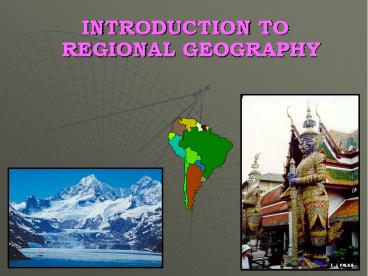INTRODUCTION TO REGIONAL GEOGRAPHY PowerPoint PPT Presentation
1 / 24
Title: INTRODUCTION TO REGIONAL GEOGRAPHY
1
- INTRODUCTION TO REGIONAL GEOGRAPHY
E.J. PALKA
2
OUTLINE
- Geography The discipline
- Geographic Realms
- Transition Zones
- Regions
- Physical Setting
3
GEOGRAPHY
- The study of place and space. The word,
spatial is a purely Geographical concept. Does
NOT refer to outer space. - Divided into Physical Human. Studies human
activity, the natural environment, and the
relationship between the two. - Studies the location and distribution of features
on the Earths surface. Answers where and why - Why is Timbuktu where it is, and why did the
settlement evolve on this site? (see handouts)
4
GEOGRAPHIC REALMS
Realms are based on Spatial Criteria
- The largest geographic units into which the
inhabited world can be divided - Based on both physical (natural) and human
(cultural) criteria
5
WORLD GEOGRAPHIC REALMS
- Geographic realms change over time.
- Where geographic realms meet, transition zones,
not sharp boundaries, mark their contacts.
6
TRANSITION ZONES
- An area of spatial change where peripheries of
two adjacent realms or regions join - Marked by a gradual shift (rather than a sharp
break) in the characteristics that distinguish
neighboring realms
7
GEOGRAPHICAL CLASSIFICATION
CONCEPT OF SCALE
The World
Realms
Regions
8
REGION
- Marked by a certain degree of homogeneity
(sameness) in one or more phenomena. In other
words, areas of similar characteristics. - Also called a uniform region or homogeneous region
Examples Corn Belt Megalopolis
9
REGIONS
- Scientific devices that enable us to make spatial
generalizations - Based on criteria we establish
- Criteria can be
- Human (cultural) properties
- Physical (natural) characteristics
- or Both
10
REGIONS
- All regions have
- Area
- Boundaries
- Location
11
THE PHYSICAL SETTING
- Physical Geography
- Alfred Wegner
- Tectonic plates
- Continental drift
- Pacific Ring of fire
12
CLIMATE
- Hydrologic cycle
- Precipitation patterns
- Climate regions
13
CULTURAL GEOGRAPHY
- A wide-ranging and comprehensive field that
studies spatial aspects of human cultures - Culture Shared patterns of learned behavior
- Components Beliefs Institutions and Technology
14
CULTURAL LANDSCAPE
- The composite of human imprints on the earths
surface. - Carl Sauers definition the forms superimposed
on the physical landscape by the activities of
man
15
CULTURAL LANDSCAPE
16
CULTURE HEARTH
- The source areas from which radiated ideas,
innovations, and ideologies that change the world
beyond
17
POLITICAL GEOGRAPHY
- A subfield within the human branch of geography
- The study of the interaction of geographical area
and political process - The spatial analysis of political phenomena and
processes
18
STATE
- A politically organized territory
- Administered by a sovereign government
- Recognized by a significant portion of the
international community. - A state must also contain
- a permanent resident population
- an organized economy
- a functioning internal circulation system
19
NATION
Must a nation be a place?
- Some examples of stateless nations the Cherokee
Nation, the Palestinians, the Kurds (see next
slide).
20
KURDISH REGION
THE KURDS
21
POPULATION DISTRIBUTION
- 4 major clusters
- 1) East Asia 2) South Asia
- 3) Europe 4) Eastern North America
22
PATTERNS OF DEVELOPMENT
- Economic geography Core areas vs. peripheries
- Economic conditions (World Banks groupings)
23
PATTERNS OF DEVELOPMENT
24
THE GEOGRAPHERS PERSPECTIVE

